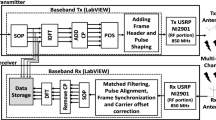Abstract
Weak L1 signal acquisition in a high dynamic environment primarily faces a challenge: the integration peak is negatively influenced by the possible bit sign reversal every 20 ms and the frequency error. The block accumulating semi-coherent integration of correlations (BASIC) is a state-of-the-art method, but calculating the inter-block conjugate products restricts BASIC in a low signal-to-noise ratio (SNR) acquisition. We propose a block zero-padding method based on a discrete chirp-Fourier transform (DCFT) for parameter estimations in weak signal and high dynamic environments. Compared with the conventional receiver architecture that uses closed-loop acquisition and tracking, it is more suitable for open-loop acquisition. The proposed method combines DCFT and block zero-padding. In this way, the post-correlation signal is coherently post-integrated with the bit sequence stripped off, and the high dynamic parameters are precisely estimated using the threshold set based on a false alarm probability. In addition, the detection performance of the proposed method is analyzed. Simulation results show that compared with the BASIC method, the proposed method can precisely detect the high dynamic parameters in lower SNR when the length of the received signal is fixed.
Similar content being viewed by others
References
Aceros-Moreno, C.A., Rodriguez, D., 2005. Fast discrete chirp Fourier transforms for radar signal detection systems using cluster computer implementations. Proc. 48th Midwest Symp. on Circuits and Systems, p.1047–1050. [doi:10.1109/MWSCAS.2005.1594284]
Belega, D., Dallet, D., 2008. Frequency estimation via weighted multipoint interpolated DFT. IET Sci. Meas. Technol., 2(1):1–8. [doi:10.1049/iet-smt:20070022]
Dai, L., Wang, Z., Wang, J., et al., 2010. Joint code acquisition and Doppler frequency shift estimation for GPS signals. Proc. IEEE 72nd Vehicular Technology Conf., p.1–5. [doi:10.1109/VETECF.2010.5594093]
Fan, B., Zhang, K., Qin, Y., et al., 2013. Discrete chirp-Fourier transform-based acquisition algorithm for weak Global Positioning System L5 signals in high dynamic environments. IET Radar Sonar Navig., 7(7):736–746. [doi:10.1049/iet-rsn.2012.0249]
Fu, H., Kam, P.Y., 2007. MAP/ML estimation of the frequency and phase of a single sinusoid in noise. IEEE Trans. Signal Process., 55(3):834–845. [doi:10.1109/TSP.2006.888055]
Geiger, B.C., Vogel, C., 2013. Influence of Doppler bin width on GPS acquisition probabilities. IEEE Trans. Aerosp. Electron. Syst., 49(4):2570–2584. [doi:10.1109/TAES.2013.6621837]
Geiger, B.C., Vogel, C., Soudan, M., 2012. Comparison between ratio detection and threshold comparison for GNSS acquisition. IEEE Trans. Aerosp. Electron. Syst., 48(2): 1772–1779. [doi:10.1109/TAES.2012.6178098]
Huang, P., Pi, Y., Progri, I., 2013. GPS signal detection under multiplicative and additive noise. J. Navig., 66(4): 479–500. [doi:10.1017/S0373463312000550]
Kay, S., 1989. A fast and accurate single frequency estimator. IEEE Trans. Acoust. Speech Signal Process., 37(12): 1987–1990. [doi:10.1109/29.45547]
Li, X., Guo, W., 2013. Efficient differential coherent accumulation algorithm for weak GPS signal bit synchronization. IEEE Commun. Lett., 17(5):936–939. [doi:10. 1109/LCOMM.2013.031913.130267]
Li, X., Guo, W., Xie, X., 2011. A GPS bit synchronization method for high-dynamic and weak signal. J. Electron. Inform. Technol., 33(10):2521–2525 (in Chinese). [doi:10.3724/SP.J.1146.2011.00270]
Shanmugam, S.K., Nielsen, J., Lachapelle, G., 2007. Enhanced differential detection scheme for weak GPS signal acquisition. Proc. Int. Technical Meeting of the Satellite Division of the Institute of Navigation, p.1–14.
Spangenberg, S.M., Scott, I., Mc Laughlin, S., et al., 2000. An FFT-based approach for fast acquisition in spread spectrum communication systems. Wirel. Pers. Commun., 13(1–2):27–55. [doi:10.1023/A:1008848916834]
Su, Y.T., Wu, R.C., 2000. Frequency acquisition and tracking in high dynamic environments. IEEE Trans. Veh. Technol., 49(6):2419–2429. [doi:10.1109/25.901910]
Yang, C., Han, S., 2001. Block-accumulating coherent integration over extended interval (BACIX) for weak GPS signal acquisition. Proc. 19th Int. Technical Meeting of the Satellite Division of the Institute of Navigation, p.2427–2440.
Yang, C., Nguyen, T., Blasch, E., et al., 2008. Post-correlation semi-coherent integration for high-dynamic and weak GPS signal acquisition. Proc. IEEE/ION Position, Location and Navigation Symp., p.1341–1349. [doi:10.1109/ PLANS.2008.4570122]
Author information
Authors and Affiliations
Corresponding author
Additional information
Project supported by the National Natural Science Foundation of China (Nos. 61172138 and 61401340), the Natural Science Basic Research Plan in Shaanxi Province of China (No. 2013JQ8040), the Research Fund for the Doctoral Program of Higher Education of China (No. 20130203120004), the Open Research Fund of the Academy of Satellite Application (No. 2014_CXJJ-DH_12), the Xi’an Science and Technology Plan (No. CXY1350 (4)), the Fundamental Research Funds for the Central Universities (Nos. 201413B, 201412B, and JB141303), and the Open Fund of Key Laboratory of Precision Navigation and Timing Technology, National Time Service Center, CAS (Nos. 2014PNTT01, 2014PNTT07, and 2014PNTT08)
ORCID: Chao WU, http://orcid.org/0000-0001-7769-6155
Rights and permissions
About this article
Cite this article
Wu, C., Xu, Lp., Zhang, H. et al. A block zero-padding method based on DCFT for L1 parameter estimations in weak signal and high dynamic environments. Frontiers Inf Technol Electronic Eng 16, 796–804 (2015). https://doi.org/10.1631/FITEE.1500058
Received:
Accepted:
Published:
Issue Date:
DOI: https://doi.org/10.1631/FITEE.1500058
Keywords
- Threshold detection
- Discrete chirp-Fourier transform
- Block zero-padding
- High dynamic
- Weak L1 signal acquisition




